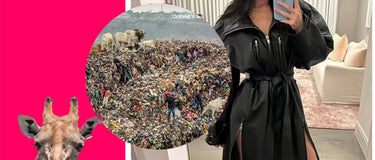

Unleash your senses, fashion aficionados, as we dive into the faux leather frenzy that's taking the world by storm. Kylie Jenner, the maestro of trends, recently birthed KHY, a brand that screams faux leather chic louder than a banshee at a rock concert. Picture this: a trenchcoat, body-con dress, and trousers that zip and unzip faster than your daily dilemmas. But here's the catch – these seemingly luxurious pieces are not leather at all. Nope, they're not swathed in the animal kingdom's finest; they're wrapped in the embrace of industrial-sized plastic.
Faux leather the cool kid?

The high street, too, is playing faux leather roulette. Marks & Spencer is peddling high-waisted "leather look" leggings so popular, they're practically online royalty. Shein, the never-ending labyrinth of fashion, has so many pages of "faux leather" that you might need a GPS to navigate through it. It's a faux leather jungle out there, and we're all just trying to find our way back to sanity.
Faux leather has been the cool kid on the block since the days of Grace Jones belting out "Warm Leatherette" in 1978. But here's the thing – most of these pleather wonders are by-products of the fossil fuel industry. We're essentially crafting a Frankensteinian material monster that's wreaking havoc on our planet like a gigantic, plastic version of Godzilla. The climate crisis is doing the cha-cha, and our ecosystems are throwing shade at our faux leather obsessions.
Now, we get it – animal-free options sound ethical and virtuous. But, much like a vegan burger at a fast-food joint, a faux leather skirt might not be the healthiest or most eco-friendly choice. We need to save ourselves and stop sugar-coating plastic as the leather messiah. Let's call these materials out for what they are and let them face the music based on their own merits.
Sadly, our faux leather fantasies often end up as textile waste, gallivanting thousands of miles away from their birthplace. For example, faux leather is haunting the landfills of Accra like a ghost from the fashion past. It’s a mountain of shame to be honest.
But fear not, eco-warriors, for there might be a glimmer of hope in the fashion abyss. Brands like Ganni are cooking up a storm with bags made from bacteria, while others are turning agricultural waste – think wine leftovers, tomatoes, pineapples, and mushrooms – into avant-garde fashion statements. Yet, the road to redemption is rocky. Coatings, especially those pesky ones made from polyurethane (PU), are fashion's guilty pleasure, and they're not recyclable.

Enter the heroes of the story – carob-inspired leather by Dio Kurazawa, Mirum by Camper, and Deadwood Studios, making cactus cool again. These innovators are flipping the script, giving Mother Earth a standing ovation.
But, alas, change takes time. Designer Alice V Robinson is on a quest for ethical real leather, crafting collections from a single animal and chronicling the odyssey in her book, "Field Fork Fashion." It's not just about launching a new material; it's about overthrowing an entire system. Leather must rise from the ashes, no longer perceived as a dime-store commodity.
LUC8K Transparency.
In the end, as we always say at LUC8K, it's about transparency. Know what you're adorning your body with, and be mindful of what happens when the thrill of the faux leather fades. We need to prioritize quality over quantity, choose timeless pieces that last, and rally behind brands committed to saving our beloved planet.
At LUC8K, we are proud to use real leather from sustainable sources. Our cows are happy cows, we make sure they live a long and free life, eating grass in the lush fields in France until the time comes for them to be used in the meat industry. We use the by-product and we don’t waste a single thing. Our bags and accessories are truly bespoke, we only ever handmake our products to order, so there’s absolutely no waste. And you know what? Our bags get better with age, so they last a lifetime. They won’t end up in a mountain of faux leather waste anytime soon.
Certainly not in our lifetime.
So, dear fashionistas, let's not just follow the trends – let's set them ablaze with a sustainable spark. The global south shouldn't bear the brunt of our fashion excesses. It's time to dress not just for the occasion but for a brighter, greener future.

